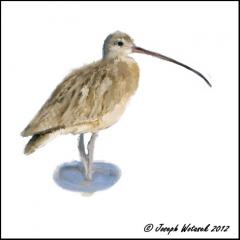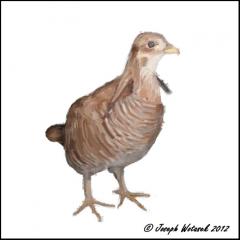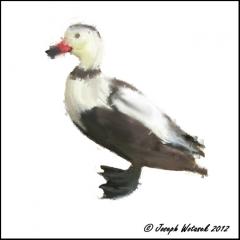Extinct Species of New Jersey
These five species have been lost forever from, not just New Jersey, but the entire planet. Their stories may help us understand how to better protect the species we still have.
- Carolina parakeet (Conuropsis carolinensis)
- Eskimo curlew (Numenius borealis)
- Heath hen (Tympanuchus cupido)
- Labrador duck (Camptorhynchus labradorius)
- Passenger pigeon (Ectopistes migratorius)
CAROLINA PARAKEET (Conuropsis carolinensis)
DESCRIPTION
This was the only member of the parrot family native to the United States. It was once found throughout the eastern half of the U.S. as far west as Colorado and as far north as Wisconsin. It was about 13 ½ inches long with a green body, yellow neck, and reddish-orange face.
The Carolina parakeet was once a very common bird in the eastern deciduous forests of the U.S. It lived in small groups but would gather in flocks numbering in the hundreds when food was abundant. Like many other parrots, this species was monogamous and long-lived.
This species fed on nuts, seeds, and fruit.
 Zoom+ Carolina parakeet.
Zoom+ Carolina parakeet.
WHEN DID IT BECOME EXTINCT?
1918
WHY DID IT BECOME EXTINCT?
Carolina parakeets began to decline with the arrival of Europeans to North America. Unlike Native Americans, European colonists cleared large areas of forest which the birds relied upon for roosting, nesting, and foraging. With the loss of food from forests, the parakeets turned to human crops, such as apples, peaches, pecans, and various grains. They were regarded as a pest by farmers. Because of this, they were hunted mercilessly. And because parakeets are very social birds, when one of their own was killed, other parakeets would stay nearby the dead individual and expose themselves to harm. Thousands of Carolina parakeets were also captured for the pet trade and many others killed for their beautiful feathers.
Today, parrots are one of the most threatened groups of bird species. This is due to both habitat loss and the relentless pet trade. Thousands of parrots are collected from the wild throughout the world each year, often illegally. As a result, over one-third of all parrot species in the world are currently considered endangered or threatened.
ESKIMO CURLEW (Numenius borealis)
DESCRIPTION
The Eskimo curlew was a shorebird which migrated through New Jersey between its summer breeding grounds in the Canadian subarctic and its wintering range in the Argentinean Pampas. The curlew typically occurred in New Jersey during its fall migration, as the species hugged the coastline as they travelled south. During the northern migration in the spring, they would fly across the prairies of the U.S. and Canada.
The Eskimo curlew was about 12 inches in length and looked like a small whimbrel (Numenius phaeopus). It had long legs and a long decurved bill. The upper part of its body was a mottled brown while its belly was paler. There were dark streaks down its neck and sides and its head pattern was more muted than a whimbrel’s.
The Eskimo curlew fed primarily on small invertebrates, such as insects. One prey species on which they were heavily dependent on, in order to fuel their enormous migrations, was the Rocky Mountain locust.
This species migrated in large flocks and was once quite common. Other shorebirds such as red knots (Calidris canutus) and sanderlings (Calidris alba) most likely migrated with the curlew flocks in the fall.
 Zoom+ Eskimo curlew.
Zoom+ Eskimo curlew.
WHEN DID IT BECOME EXTINCT?
1970
WHY DID IT BECOME EXTINCT?
Relentless hunting, conversion of prairies into agriculture, and the loss of prey species caused curlew populations to plummet. Because they migrated in such large, dense flocks, they made an easy target for hunters who could kill multiple birds with a single shot. One of their primary sources of prey during their spring migration, the Rocky Mountain locust, became extinct in 1902 after having been one of North America’s most abundant insect species.
This species, like the passenger pigeon, travelled in large flocks. It probably required a large flock size in order to persist; to avoid predators and breed successfully. Once their flocks dwindled to low numbers, their extinction became unavoidable.
Alarming parallels may be drawn between the fate of the Eskimo curlew and the increasingly imperiled red knot. The red knot, dependent upon horseshoe crab eggs to complete its similarly long migration between South America and northern Canada, has shown dramatic population declines in recent years as the number of horseshoe crabs have declined. Whether or not the red knot reaches the same population tipping point that the curlew reached, remains to be seen.
HEATH HEN (Tympanuchus cupido cupido)
DESCRIPTION
The heath hen was a subspecies of the greater prairie chicken (Tympanuchus cupido) which could once be found along the coastal plain from Massachusetts in the north to Virginia in the south. Two additional subspecies of the greater prairie chicken (Tympanuchus cupido attwateri & Tympanuchus cupido pinnatus) still exist in Texas and the U.S. Great Plains, although their populations have declined. Their preferred habitat was scrubby heathland barrens and grasslands.
The heath hen was about 17 inches in length, with a short tail and a heavily barred body with dark brown, cinnamon, and pale buff. Males had yellow-orange neck sacs which were inflated during the breeding season.
Males of this species would perform elaborate courtship displays for females. Males would gather at an elevated display area (a “lek”) and inflate their neck sacs, making booming sounds which could carry as far as a mile.
 Zoom+ Heath hen.
Zoom+ Heath hen.
WHEN DID IT BECOME EXTINCT?
1932
WHY DID IT BECOME EXTINCT?
Heath hens were once very common during Colonial times, but relentless unregulated hunting caused this species to become extinct. It was hunted for both food and sport. Unfortunately, by the time conservation measures were attempted to be implemented for this species, it was too late. The population had declined to such a small number and had become isolated on one small island (Martha’s Vineyard), that a combination of predation by goshawks and feral cats, disease introduced by domestic poultry, and inbreeding finally led to the species’ extinction.
LABRADOR DUCK (Camptorhynchus labradorius)
DESCRIPTION
The Labrador duck once lived off the coasts of the northeastern U.S. and southeastern Canada. It wintered along the coast of New Jersey and spent summers along the shorelines of Labrador and Newfoundland where it would breed and raise its young.
The Labrador duck was 22 ½ inches in length. The male had a dark body with white on the wings while the head, neck, and chest were white and there was a black stripe on its crown. The female was gray-brown with some white on the neck and wings.
This duck fed primarily on shellfish, particularly mussels, and had a very specialized bill which was soft and may have been sensitive to touch, allowing it to more effectively probe sand and mud for food. It could be found offshore or within bays and estuaries along the coast.
 Zoom+ Labrador duck.
Zoom+ Labrador duck.
WHEN DID IT BECOME EXTINCT?
1875
WHY DID IT BECOME EXTINCT?
Although this species was certainly hunted, the exact reason for its extinction is largely unknown. It appears to have not been very common in historical accounts. Its meat was said to taste foul, but nesting sites were likely disturbed or plundered for its eggs. It is possible that changes in shellfish densities or distribution may have contributed to its extinction.
PASSENGER PIGEON (Ectopistes migratorius)
DESCRIPTION
The passenger pigeon was once one of the most abundant birds in the United States, with some estimates of 3 to 5 billion birds at the time that Europeans began to colonize the Americas. They lived throughout the United States and southern Canada, east of the Rocky Mountains, and would migrate as far south as Mexico and Cuba in the winter.
The passenger pigeon is in some ways North America’s most well-known extinct bird – it went from being one of the world’s most numerous birds to being extinct in just over 100 years. It was famous for its enormous flocks of hundreds of millions of birds. Some flocks which were observed in migration were said to be over a mile in width and about 300 miles long, taking 14 hours to pass overhead.
The passenger pigeon was similar in appearance to the domestic pigeon or rock dove (Columba livia) and larger than a mourning dove (Zenaida macroura). It differed from domestic pigeons in having a more graceful, streamlined body and a longer tail. Males were about 16 ½ inches in length while females were 15 inches long. Males were blue-gray above with a pinkish belly while females had more brown above and white on the belly.
This species’ preferred habitat was dense deciduous forests, where they would feed on seeds and acorns of trees. Worms and insects would supplement their diet in summer.
 Zoom+ Passenger pigeon.
Zoom+ Passenger pigeon.
WHEN DID IT BECOME EXTINCT?
1914
WHY DID IT BECOME EXTINCT?
This species’ habit of flocking in large numbers made it vulnerable to hunters. It was often hunted as food and for sport and large numbers of birds could be killed as a flock flew overhead. Loss of forest habitat also contributed to their decline. As forests were cleared for agriculture, they had fewer safe roosting locations, less food resources, and a greater chance of being shot while out in the open.
By the 1890’s only about 250,000 birds remained and they were within a single flock. Unregulated hunting wiped-out the last wild birds and by 1914, only one passenger pigeon remained, at the Cincinnati Zoo. It is thought that this species may have required large flocks to successfully reproduce and that once their large flocks had dwindled, their eventual extinction was guaranteed.
Learn More:
Written by Michael J. Davenport in 2011.
Find Related Info: Endangered, Threatened, Shorebirds







